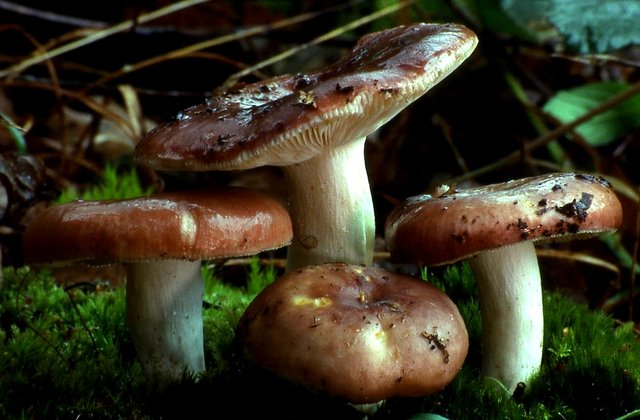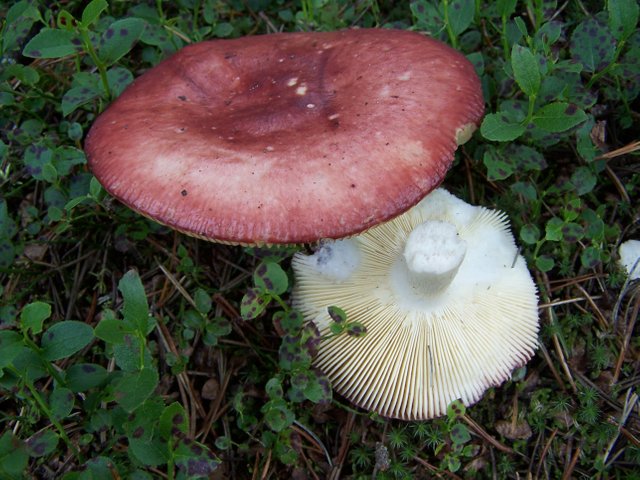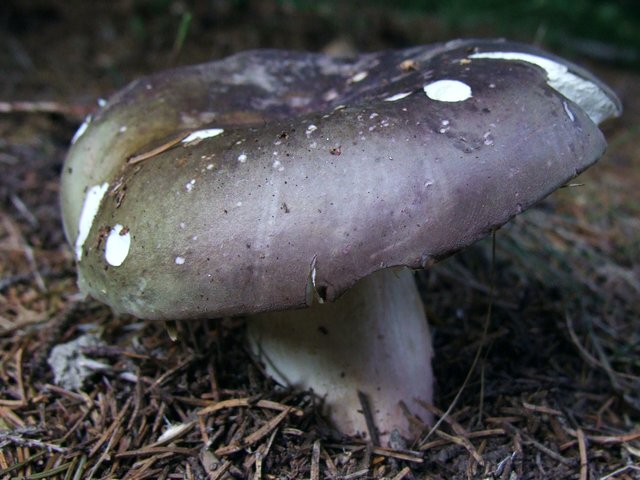How to identify edible Russula mushrooms
Russula is a genus of mushroom with lots of different edible mushrooms. They are usually pretty large, and many of them have bright colors, so they are usually very easy to spot when you are in the forest. Among the species there are some extremely delicious ones such as Russula vesca which tastes like nuts.
In this post, I want to teach you guys a little bit about the Russula mushrooms, how to identify them from other mushrooms, and how to identify edible species.

Above is the Russula vesca mushroom. Be sure to harvest this one, it's superb!
Why learn to identify Russula mushrooms?
I recommend learning to identify the Russula mushrooms because they are very easy to find in the forest, does not really look like any dangerous mushrooms, and most are either edible or non-edible but not dangerous. It's a great beginner mushroom genus, and can provide you with a decent amount of good ingredients for adding taste to soups or dishes.
There are not any dangerous Russula species in Europe or the US, but in Asia you can find Russula subnigricans, which can be deadly in a worst case scenario. So if you live in China, Japan or Taiwan you should be a lot more careful when picking Russula.
Some people claim that you can find the Russula subnigricans in the southeast US, but this has not yet been confirmed by any mycologists.

R. paludosa. Edible, but looks a lot like the inedible R. emetica (called The Sickener).
How do I know which mushrooms are in the Russula genus?
Finding out if a mushroom is part of the russula genus is actually pretty easy. They usually have brightly colored caps, and these can be yellow, red, brown, greenish, white, blackish or any shade in between. They will usually get between 6 and 10 centimeter tall, so they are not exactly large, but they are easy to spot in the forest.
All Russula species also share the following characteristics, which are used to identify them:
- They have no rings on the stem.
- They do not grow from an egg sac.
- The stem is meaty, unless it has been eaten by bugs or slugs.
- Most have a white stem, and white meat, but there are some exceptions.
- Does not have milk in their gills like the Milk Cap family does.
- The texture is very different from most other mushrooms.
I will expand a bit on that last texture part. While most mushrooms are somewhat bendable, the russula mushrooms will always break. This means it's easy to break the stem, and it will snap like a piece of chalk. The same goes for the cap. Most mushrooms will be somewhat bendable on the cap, but the cap on any russula species will snap without much effort. This feature is because the russula fungi has round cells, while most fungi has oval shaped cells.
If you find a mushroom you suspect might be a russula, throw it towards a rock or a tree and it will "explode" into many pieces, which most other mushrooms will not.
The mushrooms in the Milk Cap family also share most of these features with the russula family, but will secret a white or light colored milk from the gills when you break them.
After finding a few mushrooms that are in the russula family, you will begin to be able to identify them easily by looking at and touching the mushroom, but this takes a little bit of practice.

Russula cyanoxantha. This is one of the exceptions to the "rule" that the cap will snap easily. It's very common all over Europe, and is edible.
How to know if the Russula is edible or not
Warning, this part of the guide is based upon information from Northern Europe and the UK. I think it is also viable in the US, but definitly not in Asia. So check out local russula information if you are attempting this outside of the northern part of Europe. Don't attempt to use the below method unless you are 100 % sure you have a member of the russula genus!
Finding out if the russula is edible is actually a very cool process. It requires some bravery, but its actually not dangerous since we don't have any deadly or even dangerous members of the russula family in Europe.
What you are going to do is to break of a little bit of the flesh of the mushroom and put it on the tip of your tongue. Now, what do you feel? If it's a mild taste, the russula is edible. If it is burning on your tongue like chili, spit it out and throw the mushroom away. Some people are afraid that they will not be able to taste the difference and end up with collecting an inedible mushroom, but trust me, you will definitely know which ones to throw away! The taste from the inedible russula mushrooms is extremely strong, and you might have to eat or drink something to get the taste away.
Tasting the russula mushrooms to identify the edible ones are completely safe, but you should be sure to spit out (and not swallow) the ones that taste like chili or is burning your tongue.
With the taste test you will also get a rough expectation as to what the mushroom will taste like, but the taste will usually be a bit different once you use it in cooking.
Russula virescens. A popular, edible russula mushroom which is often considered to be one of the best russula mushrooms to use for cooking.
Thanks for reading
Thank you for reading my mushroom post! Make sure to follow me if you like these kinds of posts, and please leave a comment below if you like the article, find a mistake or error in it, or have a question. As with any mushroom guide, you should always read any identification process from several different sources before attempting to identify them yourself, but in the case of russula mushrooms you are pretty safe, because they don't really look anything like the dangerous ones.
If you want to learn about the deadly mushrooms you might come across, make sure to read by other post: 5 deadly mushrooms that you can find in the forest.
Image sources
All images are from Wikimedia Commons. Sadly I don't have many non-blurry mushrooms images to use from my own collection.
Image 1: Russula vesca. Image by Luridiformis at English Wikipedia. Image source link. Used with the Creative Commons Attribution 3.0 Unported License.
Image 2: Russula paludosa. Image by Jerzy Opioła. Image source link. Used with the GNU Free Documentation License.
Image 3: Russula cyanoxantha. Image by Jerzy Opioła. Image source link. Used with the GNU Free Documentation License.
Image 4: Russula virescens. Image by Szabi237. Image source link. Used with the GNU Free Documentation License.
Awesome post! We found some beautiful Russula mushrooms this morning in Araminda, Uruguay! This is such great information -- thanks for sharing!! 🍄 IMG_20180510_122832.jpg
Thank you! That is definitely a Russula ;)
This post has been ranked within the top 50 most undervalued posts in the second half of Nov 25. We estimate that this post is undervalued by $6.62 as compared to a scenario in which every voter had an equal say.
See the full rankings and details in The Daily Tribune: Nov 25 - Part II. You can also read about some of our methodology, data analysis and technical details in our initial post.
If you are the author and would prefer not to receive these comments, simply reply "Stop" to this comment.
Upvoted by @foraging-trail
Thank you for following and upvoting @foraging-trail
You can find out more about the Steemit Foraging community and guidelines for being upvoted by the @foraging-trail here and here.
Your post highlights how all our senses come into play with mushroom identification - even taste, when done appropriately.
I like, too, how inedible Russulas can become really edible and tasty when they are infected by a parasite. Lobster mushrooms are Zombie mushrooms - and they are delicious.
I need to spend more time looking closely at the Russula I find. So many are the bright red R. emitica. But maybe there are some good ones that I have unfairly been ignoring! I gave the Agaricus short-attention because so many in my yard are A. xanthodermus. But this year, I also got some A. campestris that were delicious. So maybe I could have the same result with the Russulas.
Yeah, the taste part is really cool for this genus, but sadly this will probably not end well if we attempt to use it for any other mushroom genus.
Yes, there are some good russulas with a red cap. Just do the taste test to determine which ones are R. emitica, because that one will definitely ruin a whole dish if mixed with other mushrooms.
I read something recently where people were using the R. emitica as chili powder, because it is so peppery. I am going to have to do more research on that, lol.
Oh, that is really cool. I have never heard of that before, but that is definitely something I would like to research and possibly try.
I bet the Nordic Food Lab folks would help you test that! They are in Denmark, I think. They try things, lol.
Nice post. Just a note about attribution. Please follow the requirements of the Creative Commons licenses for each of the images. For example, images 1, 2, and 4 require attribution to the photographer and posting a link to the license that they were published under. I couldn't tell about image 3. Thank you.
Oh, I didn't know that part. I'll make sure to check it out and update the post later today when I have some spare time :) Thanks for telling me!
Thanks for your understanding on this. We appreciate you sharing your experience and expertise with us all!
I've updated the post with attribution now :) Do you have a minute to check it out? I think it should be OK now, but I just want a second opinion to make sure I don't do anything wrong again.
We reached the end of the comment train, so I'm commenting up here. I appreciate your persistence! Happy mushroom foraging!
I like the way you did the layout for it. The links that you provide are good, because they go to the image, the creator, and the license, all in one locations. Nice. You might want to take a look at the details of the license for the Jerzy Opiola images and see if you really comply - or even want to. Sorry to be a pain about this and I hope it's not off-putting. Your posts are really nice.
Getting all the attributions correct was a little bit more work than I expected! Haha. I see now that I messed up with some of the images being GNU Licensed. Hopefully I get it right this time.
Don't worry about being a pain! It's much better that I learn how to do it correctly as soon as possible, because going back and updating every single post correctly in a few months time would be a whole lot more work. I really want to do it the correct and legal way, I just figured Wikimedia would be a little bit easier than it was.
But thanks for correcting me! I really do appreciate it :)
Nice post! Resteemed.
Thank you! :)
Very useful information thank you!
You're welcome :) Glad you enjoyed my post!
Constructive criticism, inspired by you encouraging mistakes and edits being brought to your attention:
Where you said, "by other post" I believe you intended to say, "my other post"
Thanks for letting me know about the typo ;) Unfortunately the post is too old to edit, so it will have to be like it is.
You're welcome! Yes, inspired by your prompting to alert you of potential edits/errors! Great post. Thank you! It reminded me of things I forgot and brought back to the forefront of my awareness a lot of useful information + new goodness!
Thank you!
This is so awesome! I am happy to have found you on here! (I am now following you.) I actually found you in google search results after doing some research on russulas due to another Steemit post of a mushroom the author was trying to identify.
Would love to hear your perspective on it!: https://steemit.com/photography/@poofshroom/little-gem
So cool! From Steemit to google to Steemit. I've been wondering if there was a community on here revolving around foraging and wild foods but I had yet to find it!!!!
Happy to connect with you!
If you can give me any leads or peoples to maybe follow to connect with the foraging, wild food community here, I would greatly appreciate it!
Your appreciation for nature is beautiful! from what I just seen from a quick glance at your profile/blog.
Big ups and blessings!
-Michael
Thanks for all this positive feedback! It's really cool that you googled something you saw on Steemit, and ended back up on Steemit! ;)
I took a look at the post you linked to, but as I wrote there, it's not really possible to make an identification from that picture alone. Most Russula species are also pretty difficult to identify by pictures.
For foraging posts on Steemit, make sure to follow @foraging-trail. They resteem most of the interesting foraging posts here. I think there's a pretty active foraging community here, but it's been too long since mushroom season, so I'm not really active with that at the moment (but luckily they will begin to pop up in the coming months!).
Awesome! Thanks so much! I completely the difficulty of identifying from that one picture.
Yeah! I too think that is so cool! It shows the potential of steem it and the ability for it to become a closed loop where you don't even have to go off is Steemit to access the information you are looking for. So cool!
And it's awesome your post was coming up in google search results! Not far down too if you google, russula identification, I think it was.
Thanks for the lead on @foraging-trail ! Appreciate it!
Blessings for the journey!
This one is great too - I am always hesitant to eat my finds - but this is good advice for Russulas, and I think in the US as well.
I think the Russian's have a lot of Russula species which would otherwise not be edible, but that they have a methodology for parboiling and pickling them. Takes a lot of time, and having had some Russian pickled mushrooms, I've yet to find one I enjoyed.